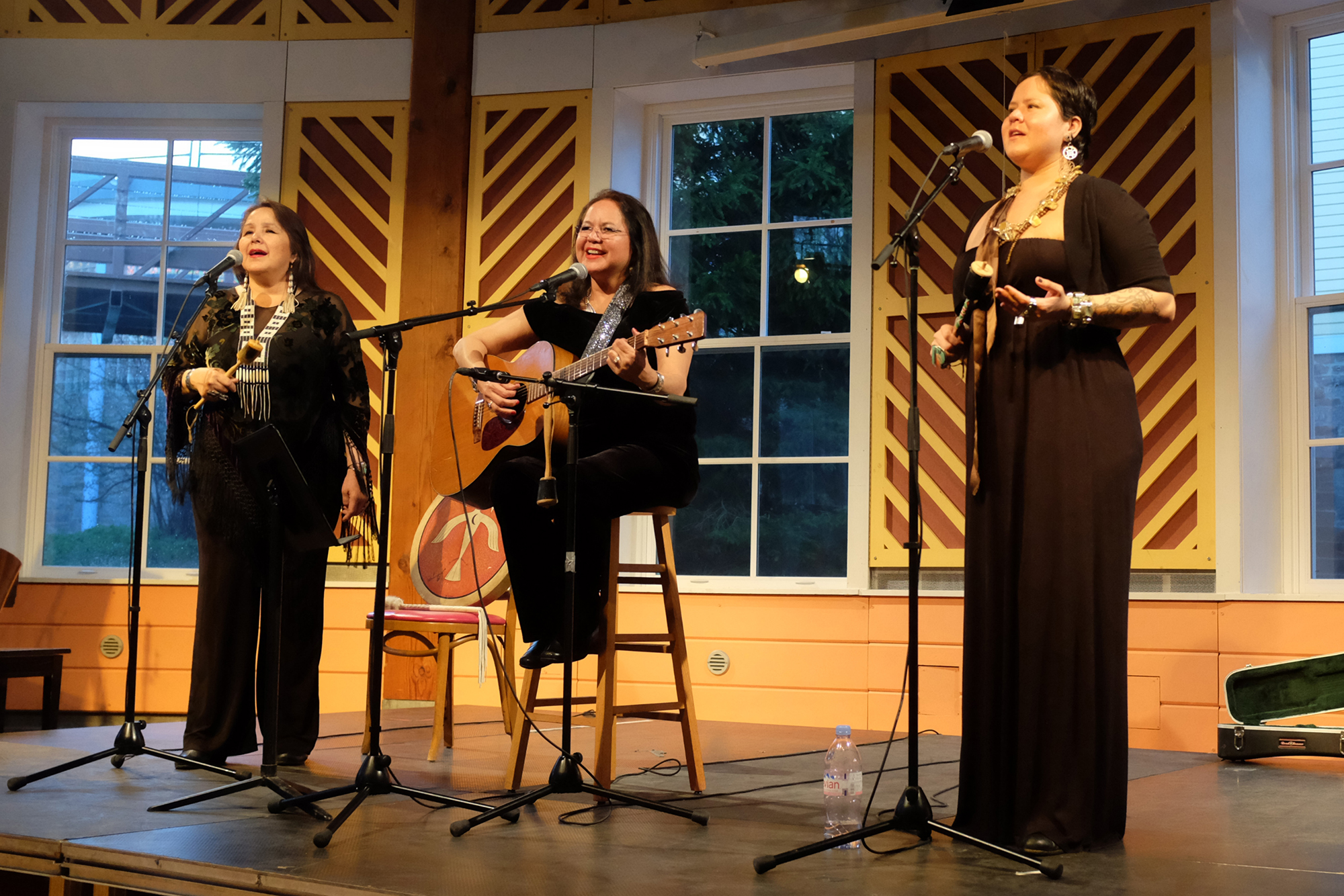
More than 220 years ago, the founder of the Hamilton-Oneida Academy, Samuel Kirkland, joined forces with Chief John Skenandoah to accomplish a noble goal. They were to found an institution of higher education, where the native population and the European colonizers could learn with, and from, one another. Seven generations later, his descendant, Joanne Shenandoah, is carrying on his dream of cultural harmony.
Joanne Shenandoah came to campus this week to deliver a presentation on Iroquois history and tradition. Shenandoah is a famous musician who has earned a Grammy, several Native American Music Awards, and has performed for the likes of the Dalai Lama and the Vatican. She was accompanied by her husband, Doug George-Kanentiio, who is a published historian and currently serves as the vice president of the Hiawatha Institute for Indigenous Knowledge.
Shenandoah began the evening with an expression of heritage, acknowledging the audience with an Oneida word that means “Greetings, I wish for great peace within you.” The word was melodic and sweet, prompting Shenandoah to describe the language as “beautiful and flowing, like a song.” She also expanded upon the idea that Oneida words are highly nuanced and expressive, a trait shared by the six dialects of the Iroquois Nation. As an example, Shenandoah explained how the phrase “I love you” in Oneida, is better translated as “How can I lift you up?”
Shenandoah brought with her several Iroquois artifacts, explaining the stories and significance of each. To preserve their culture, Maisie Shenandoah, Joanne’s mother, started collecting Iroquois artifacts; the collection has now grown to the largest in the country with over 16,000 pieces. Among these artifacts is a peace medal that was awarded to Chief Skenandoah by George Washington, one of only seven such medals to be given. Shenandoah brought a replica medal to show the audience, along with several wampum belts that represent standing peace treaties.
As a Wolf Clan Mother, Maisie was highly revered among the Iroquois tribes.
Women hold a special role in Native American cultures, esteemed as life-givers, and charged with making big decisions for the tribe. It is the women who decide if the clan will go to war, because, as Shenandoah said, they must decide if the conflict is worth losing their sons. Although the men hunt and protect the village, it’s the women who choose the chiefs and bloodlines are matriarchal.
George-Kanentiio, a member of the Mohawk tribe, spoke about the influence the Iroquois had on the budding United States. Benjamin Franklin advocated for modeling the confederacy of the 13 colonies after the Iroquois Nation, maintaining their autonomy while holding a strong common bond. The seal of the United States is almost an exact copy of the Iroquois Nation’s: the eagle, the arrows and the stars were all taken, while the olive branch replaced the original indigenous flora.
The Mohawk tribe also heavily contributed to the “American” ideals of liberty; they believed in upward mobility, arguing that social class should not be dictated by material wealth. Perhaps most importantly, they believe in freedom of spiritual expression, something coveted by Europeans systematically oppressed and executed. Many of the renowned enlightenment thinkers could not believe that such “savages” could think up these divine philosophies and wrote pieces expanding upon Iroquois ideologies.
Despite their invaluable contributions, the Mohawks, like the Oneidas, were forced off of their native land and placed on reservations. Despite a treaty with Washington, assuring that Oneida territory would remain untouched, their former land was redistributed to soldiers by the federal government who lacked other means to pay for their service.
Yet land is a sacred object to Native Americans, who believe that you may only occupy a territory insofar as you protect and beautify it. The Iroquois were wonderful foresters, revered by early settlers for their beautiful and vibrant landscapes. Once they were displaced from their hunting and fishing grounds, the Iroquois quickly sickened and thousands died. Today, the Iroquois Nation possesses just 0.037% of their original territory.
Believing in the original dream of Skenandoah and Kirkland, George-Kanentiio went on to found the Hiawatha Institute for Indigenous Knowledge, intent on embracing both cultures and exchanging knowledge. On July 1, 1794, Skenandoah joined Kirkland on the site of Hamilton College to break ground for their vision, the Hamilton-Oneida Academy.
At the end of the talk, Shenandoah reminded the audience that our presents are as inseparable as our pasts. She pointed out that one simply needs to walk to the cemetery and see the graves of Skenandoah and Kirkland side by side, per their request, to be reminded of our rich, intertwined history. Shenandoah ended with an appeal: it is not too late to fulfill the dreams of our ancestors and create an institution where Iroquois students are welcome to study and share their culture as equals.
Shenandoah returned to the Hill on May 1 for a performance in the Events Barn. She was accompanied by her sister and daughter, and performed a mix of traditional and contemporary Iroquois songs.
The lecture was sponsored by the Religious Studies department and the Hamilton College Chaplaincy.
